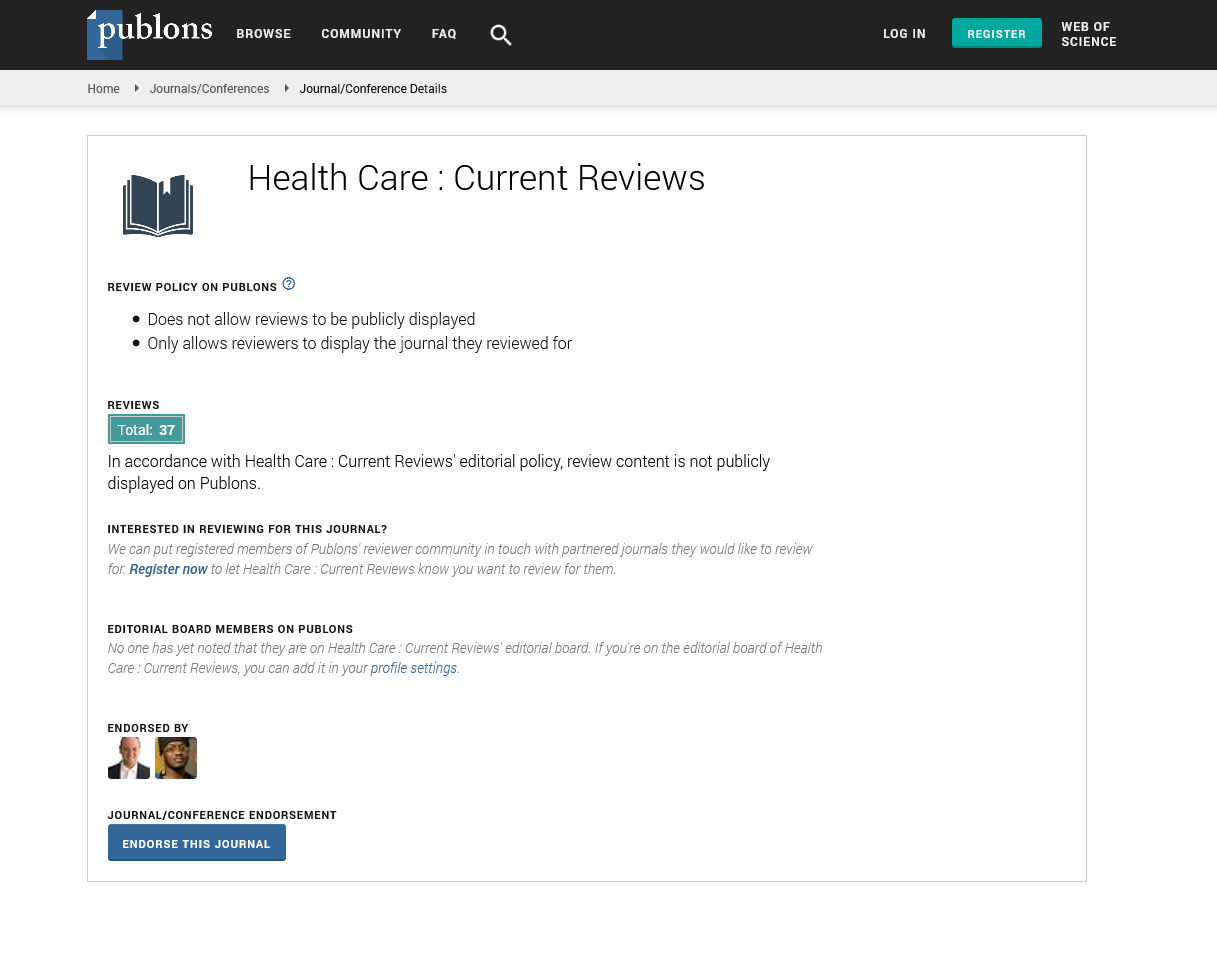Indexed In
- Open J Gate
- Academic Keys
- RefSeek
- Hamdard University
- EBSCO A-Z
- Publons
- Geneva Foundation for Medical Education and Research
- Google Scholar
Useful Links
Share This Page
Journal Flyer

Open Access Journals
- Agri and Aquaculture
- Biochemistry
- Bioinformatics & Systems Biology
- Business & Management
- Chemistry
- Clinical Sciences
- Engineering
- Food & Nutrition
- General Science
- Genetics & Molecular Biology
- Immunology & Microbiology
- Medical Sciences
- Neuroscience & Psychology
- Nursing & Health Care
- Pharmaceutical Sciences
Short Communication - (2021) Volume 9, Issue 2
Adolescent Brain and Nicotine
Luiz Antonio Del Ciampo and Ieda Regina Lopes Del CiampoReceived: 15-Jan-2021 Published: 26-Feb-2021, DOI: 10.35248/2375-4273.21.9.272
Abstract
Adolescence is a period of physical, emotional, and social changes, with significant increases in body size, physical appearance and the development of interpersonal skills necessary for successful integration into society [1]. Adolescence is also characterized by high expression of risk, exploration, search for novelties and sensations, social interaction, and playful behavior [2,3]. This period of great vulnerability, associated with impulsive actions and decisions, is linked to transformations and maturation of the central nervous system (CNS), sensitive to new experiences of plasticity that occurred in the regions of executive control and decision-making [4,5]
Keywords
Adolescence – nicotine – smoking – nicotine addiction
Introduction
Among the main experiences related to the use of legal or illegal substances, smoking and the new emerging tobacco and nicotine products are those that start earlier, reinforced by stimulation and cultural acceptance, ease of access, low cost and ignorance of the negative effects that can cause health [6,7].
Although nicotine is a psychotropic substance, with a high additive power and widely used worldwide, its use is not considered illegal. Nicotine is a potent parasympathomimetic alkaloid produced in the roots of Nicotiana tabacum, a plant found in the American continent from whose leaves it was extracted in 1828 [6,8,9]. In its pure state, nicotine is a colorless, volatile, water-soluble, bioactive alkaloid [9] absorbed by the skin, mucous membranes in the mouth and nose and pulmonary alveoli [10]. Its greatest consumption is through cigarettes that contain, on average, 14 mg, resulting in 1 to 2 mg absorbed per cigarette, although the amount provided by smoking is highly variable and dependent on the type of cigarette and the individual topography of the smoke [11] The large surface area of the small airways and the alveoli, associated with a pH of 7.4 in the lungs, allow rapid absorption of inhaled nicotine and the transition to the brain in 7 seconds, exerting its pharmacological effects on nicotine acetylcholine receptors and triggering the release of dopamine and other neurotransmitters. The cerebral half-life of nicotine is 52 minutes [6, 9, 12, and 13].
Nicotine is a neuroteratogenic substance that alters cell proliferation and differentiation, can induce epigenetic changes in the neural genome and interfere with communication systems between neurons [5, 14, and 15]. Nicotinic cholinergic transmission is a vital process for the functioning of the living organism, but vulnerable to the involvement of nicotine [8, 14]. As nicotine exerts complex actions involving different circuits and structures, even brief exposure can produce lasting changes in the adolescent brain, causing effects on the structure, function, learning and memory of the hippocampus [5, 14, and 16].
The pharmacological action of nicotine occurs by binding to presynaptic cholinergic receptors (nAchRs) located at the terminals of neurons present in the CNS and in the peripheral nervous system [6,17]. When stimulated, these receptors increase the release of several neurotransmitters, such as acetylcholine, norepinephrine, serotonin, dopamine, opioids, glutamate, beta endorphins and gamma-aminobutyric acid, involved in the induction and modulation of neuroplasticity [18-20] The neuronal receptor subtype the most abundant is alpha4 beta 2 nAchR, which has a high affinity for nicotine [5,9] and is found in the shell of the nucleus accumbens, in the ventral tegmental area and in the basolateral amygdala [21,22]. With repeated exposure to nicotine, there is an increase in the number of nAchRs. The activation of the mesolimbic dopaminergic system provides better attention and mood, stimulates memory capacity and reduces muscle tone, which is pleasant for the user, allowing him to continue using this substance and critical to the drug-induced reward system [6,9,23]
Adolescence is a critical period when drug administration can induce some effects and negatively influence neural, behavioral, and cognitive functions even long after early life exposure [24], because there are physiological, evolutionary, structural, and neurochemical changes, especially in the dopaminergic system, that accompanying the maturing process that occurs in this phase of life. The most important developmental changes in the adolescents’ brain are: non-linear reduction in cortical and subcortical grey volume, synaptic pruning, directional organization of white matter, maturation of axons, and myelination resulting in increased efficiency of impulse transduction [5, 24, and 25].
The sensitivity of the CNS to the aggressions of environmental agents depends on their state of development and nicotine use has been associated with deleterious effects in the prefrontal cortex and hippocampal structure, can lead to irreversible decreased cognitive functions, mainly attention, memory and hyperactivity [9,26]. Adolescent smoker demonstrate cognitive and behavioral impairments such as decrease of working memory, impaired serial pattern learning, deficit in attentional performance, increased anxiety and depressive-like behaviors, wake time and reduces both total sleep time and rapid eye movement sleep, inhibits prolactin secretion form the anterior pituitary and increase cortisol concentration [6,24,27-30].
Nicotine during adolescence causes acute and lasting changes in the developing brain, which in addition to the effects on the various systems and functions of the body, can lead to subsequent nicotine dependence. The rapid neuronal response to nicotine positively reinforces smoking behavior because is associated with expectation of increased well-being, and pleasure activities [9]. When dopamine levels fall, the adolescent is bound to seek more nicotine, leading to a vicious cycle that has just turned into addiction [9, 31-33].
The age of first cigarette use is critical determinant of nicotine dependence since the earlier it starts, the more difficult is to quitting [5, 34]. Also, the early use of nicotine through smoking can act as the gateway to experiment with other illicit drugs such as marijuana, cocaine, opiates, etc. [24].
Conclusions
Tobacco use is a significant public health concern because it has great potential for the development of addiction [6]. Despite all the knowledge about the damage caused by smoking, prevention and smoking cessation actions in the adolescent care environment are still few, and the damage and dependence on nicotine are a reality for adolescents with the onset of addiction occurring shortly after smoking started [35-37]. It is essential to increase educational actions on the damage caused by smoking, facilitating access to information and making exposure to cigarettes and their derivatives more difficult.
REFERENCES
- Sharma E, Seshadri SP. Adolescence: contemporary issues in the clinic and beyond. Asian J Psichiatry 2020;47:101-103.
- Crews F, He J, Hodge C. Adolescent cortical development: a critical period of vulnerability for addiction. Pharmacol Biochem Behav 2007;86:189-199.
- Leshem R. Brain development, impulsivity, risky decision making, and cognitive control: integrating cognitive and socioemotional process during adolescence - an introduction to the special issue. Develop Neuropsychol 2016; 41:1-5.
- Bernheim A, Halfon O, Boutrel B. Controversies about the enhanced vulnerability of the adolescent brain to develop addiction. Front Pharmacol 2013;4:118:121.
- Yuan M, Cross SJ, Loughlin SE, Leslie FM. Nicotine and the adolescent brain. J Physiol 2015;16:3397â??3412.
- Siqueira LM. Nicotine and tobacco as substances of abuse in children and adolescents. Pediatrics. 2017;139:1-15.
- Kalkhoran S, Benowitz NL, Rigotti NA. Prevention and treatment of tobacco use: JACC health promotion series. J Am Coll Cardiol 2018;72:1030-1045.
- Sieber M. Neuroprotective properties of nicotine. Curr Med Chem 2012;19:292-297.
- Zarrindasta M, Khakpai F. The modulatory role of nicotine on cognitive and non-cognitive functions. Brain Research 2019;1710:92-101.
- Baraona LK, Lovelace D, Daniels JL, McDaniel L. Tobacco harms, nicotine pharmacology, and pharmacologic tobacco cessation interventions for women. J Midwifery Womens Health 2017;62:253-269.
- Valentine G, Sofuoglu M. Cognitive effects of nicotine: recent progress. Cur Neuropharmacol 2018;16:403-414.
- Alkam T, Nabeshima T. Molecular mechanisms for nicotine intoxication. Neuroch Int 2019;125:117-126.
- Marsot A, Simon N. Nicotine and cotinine levels with electronic cigarette: a review. Int J Toxicol 2016;35:179-185.
- Ginzel KH, Maritz GS, Marks DF, Neuberger M, Pauly JR, Polito JR et al. Critical review: nicotine for the fetus, the infant and the adolescent? J Health Psychol 2007;12:215-224.
- Abreu-Villaça Y, Seidler FJ, Tate CA, Slotkin TA. Nicotine is a neurotoxin in the adolescent brain: critical periods, patterns of exposure, regional selectivity, and dose thresholds for macromolecular alterations. Brain Res 2003;979:114-128.
- Ferrea S, Winterer G. Neuroprotective and neurotoxic effects of nicotine. Pharmacopsych 2009;42:255-265.
- Franken RA, Nitrini G, Franken M, Fonseca AJ, Leite JCT. Nicotine. Actions and interactions. Arq Bras Cardiol 1996;66:371-373.
- Grundey J, Barlay J, Batsikadze G, Kuo MF, Paulus W, Nitsche M. Nicotine modulates human brain plasticity via calcium-dependent mechanisms. J Physiol 2018;596:5429-5441.
- Silva MTB, Araujo FLO, Felix FHC, Simão AFL, Lobato RFG, Sousa FCF et al. Alcohol and nicotine: mechanisms of dependence. Rev Neurocienc 2010;18:531-537.
- Planeta CS, Cruz FC. Neurophysiological basis of tobacco dependence. Arch Clin Psych 2005;32:25125-8.
- Dao JM, McQuown SC, Loughlin SE, Belluzzi JD, Leslie FM. Nicotine alters limbic function in adolescent rat by a 5-HT1A receptor mechanism. Neuropsychopharmacol 2011;36:1319â??1331.
- Ziedonis D, Das S, Larkin C. Tobacco use disorder and treatment: new challenges and opportunities. Dialogues Clin Neurosci. 2017;19:271â??280.
- Mahase E. Half of smokers think nicotine vaping products are at least as harmful as smoking. BMJ 2020;368:1.
- Salmanzadeh H, Ahmadi-Soleimani SM, Pachenari N, Azadi M, Halliwell RF, Rubino T et al. Adolescent drug exposure: A review of evidence for the development of persistent changes in brain function. Brain Res Bull 2020;156:105-117.
- Paus T. Growth of white matter in the adolescent brain: Myelin or axon? Brain Cogn 2010;72:26â??35.
- England LJ, Bunnell RE, Pechacek TF, Tong VT, McAfee TA. Nicotine and the developing human: a neglected element in the electronic cigarette debate. Am J Prev Med 2015;49:286-293.
- Holliday ED, Nucero P, Kutlu MG, Oliver C, Connelly KL, Gould TJ et al. Long-term effects of chronic nicotine on emotional and cognitive behaviors and hippocampus cell morphology in mice: comparisons of adult and adolescent nicotine exposure. Eur J Neurosci 2016;44:2818â??2828.
- Ehlinger, D.G., Bergstrom, H.C., Burke, J.C., Fernandez, G.M., McDonald, C.G., Smith, R.F. Adolescent nicotine-induced dendrite remodeling in the nucleus accumbens is rapid, persistent, and D1-dopamine receptor dependent. Brain Struct. Funct. 2016;221:133â??145.
- Portugal GS, Wilkinson DS, Turne, JR, Blendy JA, Gould TJ. Developmental effects of acute, chronic, and withdrawal from chronic nicotine on fear conditioning. Neurobiol Learn Mem 2012;97:482â??494.
- Renaud SM, Pickens LRG, Fountain SB. Paradoxical effects of injection stress and nicotine exposure experienced during adolescence on learning in a serial multiple choice (SMC) task in adult female rats. Neurotoxicol Teratol 2015;48:40â??48.
- Conti AA, McLean L, Tolomeo S, Steele JD, Baldacchino A. Chronic tobacco smoking and neuropsychological impairments: A systematic review and meta-analysis. Neurosci Biobehav Rev 2019;96:143-154.
- Kutlu MG, Gould TJ. Nicotinic modulation of hippocampal cell signaling and associated effects on learning and memory. Physiol Behav 2016;155:162-171.
- Zeid D, Kutlu MG, Gould TJ. Differential effects of nicotine exposure on the hippocampus across lifespan. Cur Neuropharmacol 2018;16:388-402.
- Kendler KS, Myers J, Damaj MI, Chen X. Early smoking onset and risk for subsequent nicotine dependence: a monozygotic co-twin control study. Am J Psychiatry 2014;170:408â??413.
- Shao XM, Fang ZT. Severe acute toxicity of inhaled nicotine and e-cigarettes. Chest 2020;157:506-508.
- Prokhorov AV, Calabro KS, TamÃ-Maury I. Nicotine and tobacco use prevention among youth and families. Sem Oncol Nurs 2016;32:197-205.
- Cavallo DA, Krishnan-Sarin S. Nicotine use disorders in adolescents. Pediatr Clin N Am 2019;66:1053â??1062.
Citation: -
Copyright: -
Sources of funding : -

